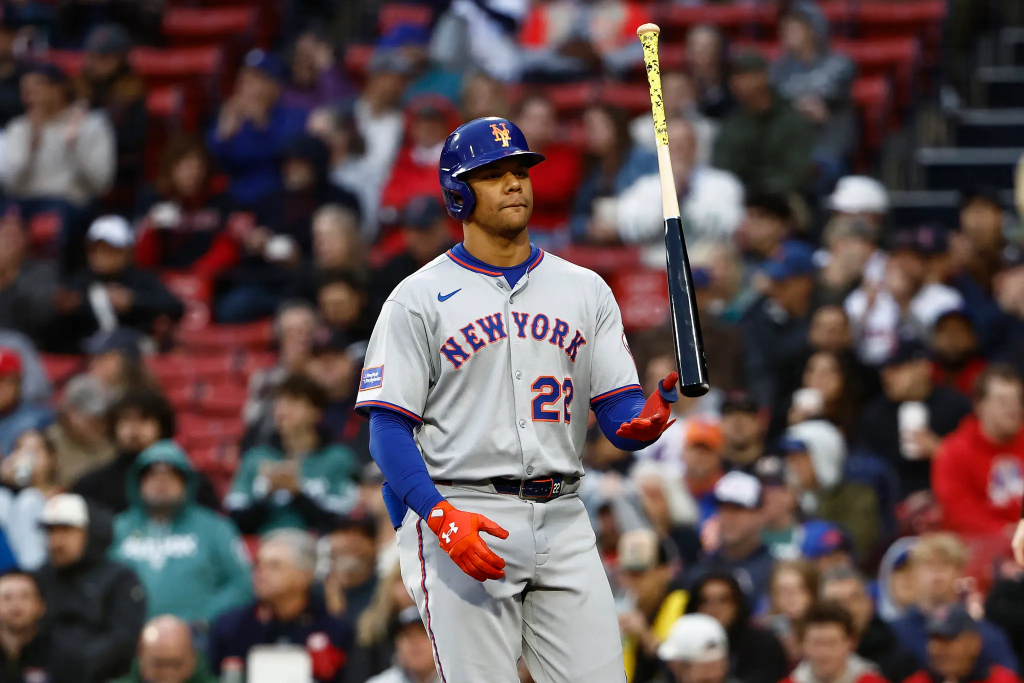Despite high expectations and a historic contract, Juan Soto has struggled to find his power stroke in his first 49 games with the New York Mets. Statistical trends reveal the hidden challenges behind his slow start and suggest areas where the star outfielder must improve to meet the lofty standards set for him.
A surprising dip in bat speed and power
Juan Soto’s 2025 campaign has been far from what Mets fans and analysts anticipated. After signing the largest contract in Big Four sports history worth $765 million, Soto entered the season with immense pressure to deliver, yet his performance has been underwhelming, particularly in terms of power hitting. His current slugging percentage of .429 marks a career low and sits .140 points below his 2024 figure with the Yankees.

One of the most revealing insights into Soto’s struggles is a significant decline in bat speed. His average bat speed has dropped by 2.0 miles per hour compared to last year, now measuring 73.4 mph. This reduction may seem minor to casual observers, but in the world of professional baseball, such a drop is an anomaly, especially for a 26-year-old hitter in his prime. For context, Aaron Judge’s bat speed this season stands at 76.6 mph, illustrating the level of power potential Soto has yet to consistently unlock.
Bat speed directly correlates with a player’s ability to generate power, which helps explain why Soto is on pace to hit only about 26 home runs this season. This would be his fewest in a full 162-game season since his rookie year in 2018, a sharp contrast to the 41 homers he smashed with the Yankees last year.
Struggles against velocity and elite pitching
Soto’s power woes also reflect his difficulties handling high-velocity pitches this season. Against pitches thrown at 95 mph or faster, Soto’s batting average has plummeted to .167, with a dismal on-base percentage of .265 and slugging percentage of .375, according to detailed analyses by Sports Illustrated. This stands in stark contrast to his 2024 numbers against similar velocity offerings, when he hit .347 with a .718 OPS, demonstrating a clear regression.
Additionally, Soto has struggled against “power pitchers” — those ranked in the top third of the league for combined strikeouts and walks. Against these pitchers, he has posted a batting average of just .121 and an OPS of .582 this season, a worrying sign given his career history of success against high-caliber pitching.
The decline extends to other metrics as well. His barreling rate — a key indicator of how often a hitter makes optimal contact — has dropped to 14.0 percent, down 5.7 percent from the previous year. Although still slightly above his career average, this dip signals less consistent hard contact.
Issues against right-handed pitching and team impact
Another troubling area for Soto has been his performance against right-handed pitching. Historically, the outfielder has been dominant in these matchups, boasting a .553 slugging percentage and a robust .987 OPS over his career. This year, however, those numbers have fallen to a .430 slugging percentage and a .771 OPS, further fueling concerns about his diminished offensive impact.
The Mets, struggling with overall offensive consistency, have not helped Soto either. His lack of run support has been evident in recent games, contributing to the frustration around his performance. Manager Carlos Mendoza acknowledged the difficulties Soto is facing but expressed confidence in his star player’s work ethic and desire to improve.
“A lot of times their frustrations are going to get the best of them, especially a guy like that — he’s so talented and has had so much success early in his career,” Mendoza said. “Right now, he feels maybe he could do a little bit more for the team. He’s part of it and that is part of the conversation here, understanding the personnel. But at the same time, a guy like him wants to be coached, wants to be challenged. That’s what makes him special.”
Can Soto rebound?
Juan Soto’s start with the Mets has undoubtedly been disappointing given the hype surrounding his arrival. But the detailed statistical analysis provides a clearer picture of why his power has not yet fully materialized. The drop in bat speed, struggles against velocity and power pitchers, and diminished success against right-handers all suggest there are technical and perhaps mental adjustments Soto needs to make.
With his talent and proven track record, the potential for a midseason turnaround remains. Mets fans and baseball observers alike will be watching closely to see if Soto can regain his trademark power and become the franchise cornerstone they expect him to be. Until then, the numbers serve as a reminder that even the biggest stars can face challenging slumps in the unforgiving world of Major League Baseball.





